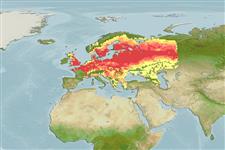Classification / Names
Common names from other countries
Main reference
Size / Weight / Age
Max length : 64.0 cm TL male/unsexed; (Ref. 6114); common length : 15.0 cm TL male/unsexed; (Ref. 556); max. published weight: 3.0 kg (Ref. 556); max. reported age: 10 years (Ref. 59043)
Environment
Freshwater; brackish; demersal; potamodromous (Ref. 51243); depth range 5 - ? m (Ref. 2163)
Climate / Range
Temperate; 2°C - 22°C (Ref. 1672), preferred ?; 69°N - 35°N, 10°W - 169°E
Distribution
Eurasia: North, Baltic, White, Barents, Black and Caspian Sea basins; Aegean Sea basin only in Maritza drainage; eastward to Kolyma drainage (Siberia); westward to Rhine and eastern drainages of England. Absent from North Sea basin in Sweden and Norway. In Baltic basin north to about 66°N. Widely introduced to Italy, England and France but possibly often confused with Carassius gibelio (Ref. 59043). At least one country reports adverse ecological impact after introduction.
Countries | FAO areas | Ecosystems | Occurrences | Introductions
Short description
Dorsal
spines
(total): 3 - 4;
Dorsal
soft rays
(total): 13-22;
Anal
spines: 2-3;
Anal
soft rays: 5 - 7;
Vertebrae: 32. Diagnosed from its congeners in Europe by having the following characters: body golden-green shining color; last simple anal and dorsal rays weakly serrated; 23-33 gill rakers; lateral line with 31-36 scales; free edge of dorsal convex; anal fin usually with 6½ branched rays; and peritoneum white (Ref. 59043). Caudal fin with 18-20 rays (Ref. 2196). No barbels. The third dorsal and anal-fin rays are strong and serrated posteriorly.
IUCN Red List Status (Ref. 115185)
Threat to humans
Potential pest (Ref. 13686)
Human uses
Fisheries: highly commercial; aquaculture: commercial; gamefish: yes; aquarium: commercial; bait: occasionally
Tools
Special reports
Download XML
Internet sources
Estimates of some properties based on models
Phylogenetic diversity index
PD50 = 0.5312 many relatives (e.g. carps) 0.5 - 2.0 few relatives (e.g. lungfishes)
Trophic Level
3.1 ±0.24 se; Based on food items.
Resilience
Medium, minimum population doubling time 1.4 - 4.4 years (tm=2)
Vulnerability
Moderate vulnerability (38 of 100)
Price category
